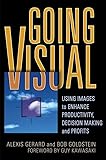Going Visual: Using Images to Enhance Productivity, Decision-Making and Profits

Author: Alexis Gerard
Year: 2005
Publisher: John Wiley & Sons
ISBN: 0471710253
This is one of those examples of a gem of a good idea that would be more valuable if it weren’t bulked up to fit into a book size format. It could be a substantial article idea or even an excellent blog, but it proves a bit disappointing as a book.
The basic notion is to become more systematic about taking advantage of the cost and ease of digital imagery in a variety of business processes. Gerard and Goldstein offer case studies of a property management firm, a small entrepreneur, and outdoor advertising making effective use of digital photography in their respective businesses.
For example, using digital photos to help manage multiple properties in place of detailed reports is obvious, once someone has pointed it out. The essential notion of examining business processes to identify opportunities where digital images can enhance or improve the process is an excellent insight and the case examples give you plenty of insight into how to apply the concept to your own situations. The particular management framework the authors suggest feels thin.
For the $20 it will cost you at Amazon and the hour or two it will take to get through (if you read slowly), this is probably worth while for the case examples alone. Although the authors did create a blog and website to accompany the book, the site appears to be essentially dormant, which is unfortunate as this is a topic that lends itself well to this format.
